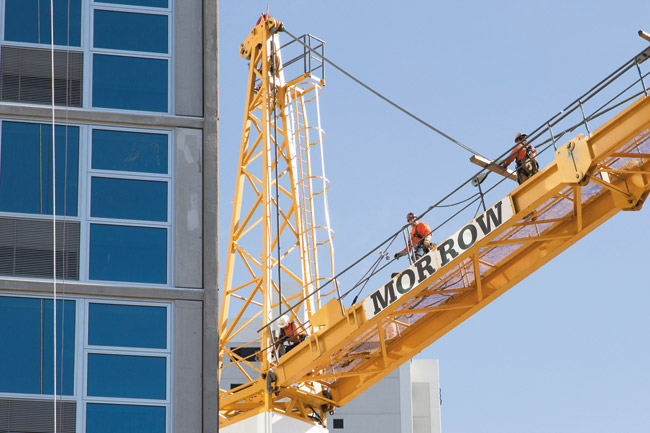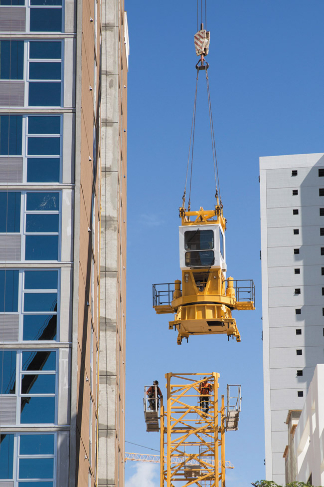Return Of The Hawaiian Cranes
It used to be a joke among Isle residents that the crane should replace the Nene as the state bird. Not the avian crane species, but the machine-operated behemoth that crowded the city skyline during its construction boom in the 1960s and ’70s.
More than half a century later, that joke is making a comeback – all it takes is a drive between Kakaako and Ala Moana to realize it.
Major crane provider Morrow Equipment Company LLC – which functions as the rental and sales dealer of Liebherr Tower Cranes in the United States – says it currently has eight tower cranes in use in the state.
By the end of the year, residents should expect to see anywhere from 15 to 20.
Looking up at one from the ground, it may be hard to see, but at the very top of each crane sits an operator. There, they spend eight hours or more a day, communicating with workers on the ground and guiding the crane’s every move.
Some of us may think it’s easy. Others probably will never even think of climbing its 250-something steps to spend a day in relative solitude.
But for a select group of operators, getting a seat in a tower crane is, well, the pinnacle of their careers.
The instructor and union organizer
To become a tower crane operator is no easy feat, though the payoff can be worthwhile. Tower crane operators make between $38 and $39 an hour.
All crane operators in the state are required to be licensed through the National Commission for the Certification of Crane Operators (NCCCO).
In order to obtain a license, hopeful operators are required to pass a written and practical exam.
“Any contractor who sees a NCCCO card knows that person went through that training, and so that’s extra training the contractor doesn’t have to provide,” says Angie Chinen, instructor/coordinator for Operating Engineers Local No. 3 Joint Apprenticeship Committee (JAC).
Chinen, a tower crane operator for nine years, has been preparing candidates for the written exam since last July.
The written test covers topics ranging from Occupational Safety and Health Administration (OSHA) rules and regulations. The practical exam, meanwhile, is completed at Local 3’s training facility in Rancho Murieta, Calif., and requires successful completion of an obstacle course.
“The practical exam shows the contractor that the operator possesses the skill to manipulate the crane in tight areas,” explains Chinen.
Standardized across the nation within Local 3, the union works to provide necessary training and certification for its operators.
“(The union) certifies the crane operator (and) updates the crane operator’s certification every three or five years,” says Donald Gentzler, Operating Engineers Local No. 3 business agent.
Gentzler spent about 20 years operating a variety of cranes for Hawaiian Dredging Construction Company Inc., then moved into tower cranes for five years. After joining the union’s staff, Gentzler no longer operates tower cranes.
“You can’t just walk into it, you’ve got to want it,” he says of becoming a tower crane operator. “That’s what I learned.”
The novice
Though not completely new to the realm of crane operating, Daniel Ku only recently completed his first job as a tower crane operator.
“When I got my first crane license, (I said) one day, I’m going to get a tower,” he says.
Ku recently completed his first project at Stanford Carr’s Halekauwila Place in Kakaako for what will eventually become affordable rentals. His days consisted of eight-hour shifts, and Ku chose to spend the entire day in the crane’s cab – to climb up took him 15 to 20 minutes.
The solitude of being in the cab alone each day, not having a bathroom and the sheer height of the crane are all things that don’t bother him.
“Once you prep and know what you need, and find your groove of the things that you need to be there, it’s all right,” he says.
His work is aided by technology. Computers guide him, and a camera on the hook of the crane allows him to clearly see what he is picking up, and it assists in blind spots.
One of the biggest challenges, he says, is the wind. Gusts as low as 15 mph will cause the tower to sway, and even picking up a load may pull the crane in a certain direction.
“The whole tower leans,” he says. “It’s designed to flex; anything too rigid, it snaps.”
Though he says others may think his job is easy, it’s one he takes seriously.
“You have to sit in that seat, take that responsibility for all these people who are working around you, and (feel) confident enough that you are able to maneuver and do your job,” he says. “I think that’s one thing that people should understand, that it’s not an easy job.”
The veterans
For some tower-crane operators, being in the seat longer also has meant having front-row seats to some of the biggest projects in the nation.
A third-generation crane operator, Jeremy Howins has been operating cranes for almost 24 years. The tallest crane he ever has worked in came in just under 600 feet and was used during a two-year project on the Tacoma Narrows Bridge in Washington state. In addition to that, he has worked on the CenturyLink Field, home to the Seattle Seahawks, and Safeco Field. Locally, his projects include Aulani resort and the wind turbines on Maui and in Haleiwa, among others.
“It’s just like getting in (my) car now to me,” he says.
Currently, Howins is working on the Ewa Wing expansion at Ala Moana Center in a tower crane almost 200 feet tall.
“Being a member of Local 3 has been really great,” he says, “and also a part of the Hawaiian Dredging family – they’re very safety-conscious and (have) great management.”
Jonni Burich’s story is a little different.
One of only a few female crane operators in the state, Burich has a degree in fashion and previously worked in a variety of jobs, including modeling for sports products. Her transition to crane operating came at a time when Burich was looking for steady pay, and the industry was in need of more female operators.
“It never occurred to me that the guys would let a woman (into) this industry,” she says.
Since then, she has been operating tower cranes for more than 10 years. Now, she says, the job has become enjoyable, and despite the noise of the crane, Burich finds her days in the cab of the tower crane peaceful.
“The tower crane – not any other crane, but the tower crane – you’re in a different world, you’re truly in a different world up there,” she says.







